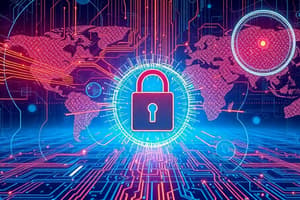Podcast
Questions and Answers
What is the primary goal of establishing security within an organization?
What is the primary goal of establishing security within an organization?
- To ensure data is always accessible
- To eliminate all technological risks
- To understand how security functions as a whole (correct)
- To achieve a perfect security system
Which of the following is NOT mentioned as an essential governance or operational process?
Which of the following is NOT mentioned as an essential governance or operational process?
- Security audits
- Employee training programs (correct)
- Incident management response process
- Risk assessments on internal systems
How did the early Internet deployments treat security?
How did the early Internet deployments treat security?
- As a low priority compared to functionality (correct)
- As a high priority due to increasing threats
- With advanced technologies and solutions
- As an essential part of governance
What is the implication of the phrase 'the ability to secure a computer’s data'?
What is the implication of the phrase 'the ability to secure a computer’s data'?
Which specialized area of security includes the protection of voice and data networking components?
Which specialized area of security includes the protection of voice and data networking components?
What is the primary purpose of the CNSS Security Model?
What is the primary purpose of the CNSS Security Model?
Which of the following is NOT a measure to protect confidentiality?
Which of the following is NOT a measure to protect confidentiality?
What characterizes the integrity of information?
What characterizes the integrity of information?
Which statement best describes authorization?
Which statement best describes authorization?
What does accountability ensure in information security?
What does accountability ensure in information security?
Which of the following best describes management?
Which of the following best describes management?
What does the 'leading' function in management emphasize?
What does the 'leading' function in management emphasize?
Which approach to management includes staffing as a core principle?
Which approach to management includes staffing as a core principle?
What is the primary role of governance in an organization?
What is the primary role of governance in an organization?
In the management process, what does 'controlling' ensure?
In the management process, what does 'controlling' ensure?
What are the primary components of information security?
What are the primary components of information security?
What does the CNSS Security Model primarily identify?
What does the CNSS Security Model primarily identify?
Which of the following is NOT a characteristic that gives information its value?
Which of the following is NOT a characteristic that gives information its value?
Which of these components is included in an information system?
Which of these components is included in an information system?
In the context of information security, what do the letters C.I.A. stand for?
In the context of information security, what do the letters C.I.A. stand for?
Flashcards
Physical Security
Physical Security
The protection of physical items, objects, or areas from unauthorized access and misuse.
Operational Security
Operational Security
The protection of an organization's operational details and activities.
Communications Security
Communications Security
The protection of all communications media, technology, and content.
Network Security
Network Security
Signup and view all the flashcards
Information Security (InfoSec)
Information Security (InfoSec)
Signup and view all the flashcards
What is an information system (IS)?
What is an information system (IS)?
Signup and view all the flashcards
What is information security?
What is information security?
Signup and view all the flashcards
What are the core principles of the C.I.A. triangle?
What are the core principles of the C.I.A. triangle?
Signup and view all the flashcards
What is the CNSS Security Model?
What is the CNSS Security Model?
Signup and view all the flashcards
What are the key components of information security implementation?
What are the key components of information security implementation?
Signup and view all the flashcards
Authorization
Authorization
Signup and view all the flashcards
Integrity
Integrity
Signup and view all the flashcards
Accountability
Accountability
Signup and view all the flashcards
Availability
Availability
Signup and view all the flashcards
Confidentiality
Confidentiality
Signup and view all the flashcards
What is management?
What is management?
Signup and view all the flashcards
What is leadership?
What is leadership?
Signup and view all the flashcards
What is planning in management?
What is planning in management?
Signup and view all the flashcards
What is organizing in management?
What is organizing in management?
Signup and view all the flashcards
What is controlling in management?
What is controlling in management?
Signup and view all the flashcards
Study Notes
Information Security Management - CYBER 322
- Information security management encompasses the secure operation of an organization.
- The goal of this course is to examine security functions within an organization.
- Technology alone is insufficient to guarantee security; essential governance and operational processes are critical.
- Key processes include incident management, data classification, risk assessments, security audits, and governance, risk, and compliance.
- Almost half of respondents attribute security incidents to current employees, and 28% to former employees.
- Information security is synonymous with computer security and is not solely the responsibility of a specific group within a company.
- Security involves protection from danger, loss, damage, modification, and other hazards.
- Specialized security areas include physical security (protection of physical assets), operations security (protecting operational details), communications security (protecting communications media, technology, and content), and network security (protecting network components, connections, and content).
- Information security encompasses the protection of information's characteristics like confidentiality, integrity, and availability.
- This includes policy, training programs, and technology to achieve these goals.
- The role of information security is to protect an organization's information assets.
- Components of an information system include software, hardware, data, people, procedures, and networks.
- Key information security concepts include access, assets, attacks, controls/countermeasures, exploits, exposure, loss, protection profiles/security postures, risk, subjects/objects, threats, threat agents, and vulnerabilities.
- The CNSS Security Model, a more detailed perspective on information security, covers confidentiality, integrity, and availability of information, with emphasis on identifying gaps in existing security programs. This covers network security, computer/data security, and management of information security.
- The CIA triad (confidentiality, integrity, and availability) expanded to include identification, authentication, authorization, privacy, and accountability as critical characteristics of information.
- Confidentiality protects information from unauthorized access. Measures to protect confidentiality include information classification, secure document storage, established security policies, and educating staff on information handling.
- Integrity ensures information is complete, accurate, and uncorrupted. Threats to integrity include corruption, damage, destruction, and other disruptions.
- Availability ensures authorized users can access required information. Availability isn't universal access but rather access for authorized users.
- Identification is when a system recognizes individual users. Authentication confirms a user's claimed identity, whereas authorization grants access based on verified identity.
- Privacy ensures information is only used for the purposes for which it was collected.
- Accountability ensures activities can be attributed to a person or process.
- Management is the process of achieving objectives by using resources effectively and efficiently. Leadership involves influencing others to achieve objectives. Management includes planning, organizing, leading, controlling.
- Traditional management theory involves planning, organizing, staffing, directing, and controlling (POSDC). Popular management theory focuses on planning, organizing, leading, and controlling (POLC).
- Management characteristics include planning, organizing, leading, controlling, and solving problems.
- InfoSec management planning includes incident response, business continuity, disaster recovery, policy, personnel, technology rollout, risk management, and security program planning. InfoSec also includes education, training, and awareness.
- Policies are organizational guidelines dictating behavior. Categories include enterprise, issue-specific, and system-specific policies.
- Programs are InfoSec operations, like security education programs, and physical security procedures.
- Protection encompasses risk management activities including risk assessment, protection mechanisms, technologies, and tools.
- People in an organization play a critical role in the InfoSec program, and effective staffing as well as training are essential.
- Project management is crucial for InfoSec projects like implementing new security measures or rolling out security training programs.
Studying That Suits You
Use AI to generate personalized quizzes and flashcards to suit your learning preferences.
Related Documents
Description
This quiz explores the fundamental concepts of information security and the roles of management within an organization. Questions cover essential governance processes, the interplay between security measures, and the integrity of information. Test your understanding of these crucial topics to ensure a secure organizational environment.




